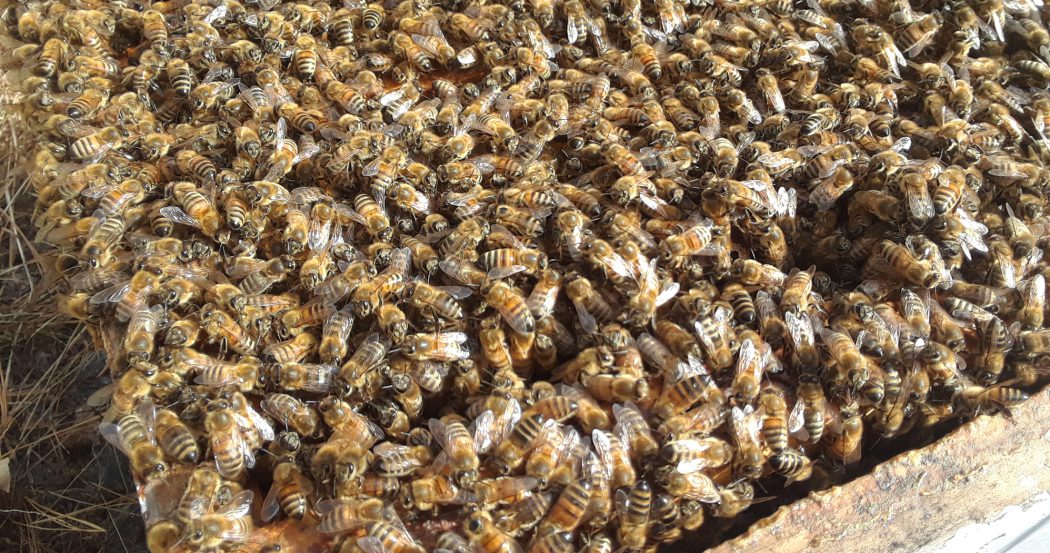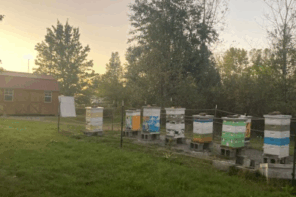Numbers
By: Becky Masterman & Bridget Mendel
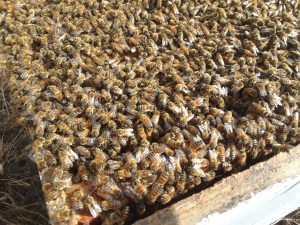
Successful beekeepers track numbers throughout their colonies and apiaries over time. Knowing varroa mite loads might help explain colony death. Honey production yields can reflect habitat quality around your apiaries. Photo credit: Rebecca Masterman
Managing bees is kind of a numbers game. Not in the illegal gambling sense, but instead in the measuring bee health and business sense. New beekeepers are warned about the importance of counting varroa mite numbers in their colonies and hear stories about high percentages of colony loss. Long time beekeepers and many commercial operations remember stories of high honey yields and market prices that are impacted by imports. Whether you are new to beekeeping or a long-time participant, keeping track of key numbers could be good for you, the bees and beekeeping.
It has been said often that beekeeping is local, so your beekeeping numbers should be too. Honey yields per colony vary greatly from state to state (and apiary to apiary within a state and hive to hive within an apiary) as do the pounds of honey that bees need to get through Winter or dearth periods. Tracking key numbers within your state each year can serve as a bee health conversation starter. Let’s hope that the conversations continue each year and are about lower colony losses and higher honey yields.
Here are some numbers that we think are important.
Varroa Mite Loads
Let’s get the mite talk out of the way and address it right away. Varroa mites and the viruses they vector are still one of the greatest threats to the health of your honey bee colonies. Successful beekeepers keep on top of the latest management recommendations and know the threshold where intervention is key to maintaining healthy bees. This threshold might be different than what you think and the threshold changes depending on the time of year. Monitoring mite loads is important. Keeping up on the latest research-based recommendations is also critical to successful beekeeping as your management will change over the years as the threats to your bees change (anyone remember tracheal mites?). This excellent update from the Bee Informed Partnership will bring you up to date on mites as well as provide a link to the latest free edition of Tools for Varroa Management from the Honey Bee Health Coalition. While you are there, we suggest signing up for updates from the Bee Informed Partnership (https://beeinformed.org/2023/03/01/the-importance-of-spring-mite-loads).
Colony Loss Data
Let’s also get the colony loss data out of the way. Following significant colony losses across the U.S. in 2006, the Bee Informed Partnership has been tracking colony losses across the U.S. You can contribute to the survey each year in April by reporting your losses. Reported loss data by states is available all the way back to 2008 (https://research.beeinformed.org/loss-map/).
Honey Market Numbers
The National Honey Board compiles honey data from multiple sources on their website and you can easily spend some time looking at the numbers (https://honey.com/honey-industry/market-overview). For a monthly regional report, Bee Culture’s detailed guide will provide everything you need to know (https://beeculture.com/monthly-regional-honey-price-report/).
Honey Yields
If you want to explore your state honey data, the USDA National Agricultural Statistics Service has a searchable database for all things honey and bees, including reported honey yield per colony. You can search national as well as state data across more than 30 years (https://quickstats.nass.usda.gov/).
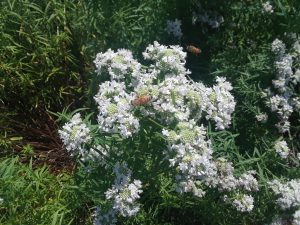
Measuring available habitat for your bees is difficult but doing so might inspire others to increase floral resources for pollinators. These bees are enjoying the blooming mountain mint planted in the apiary. Photo credit: Rebecca Masterman
Because honey bees are managed pollinators, it is easier to track the numbers described before. One other number that is more difficult to track, yet very important, when talking about honey bee health is Acres of Pollinator Habitat.
How much pollinator habitat is available for bees in your state? It is a difficult number to track as counting the flowers on trees, shrubs, prairies, conservation land, cover crops and more (bee lawns, gardens, roadside habitat, etc.) is not easy, but we love those who are trying to do just that. Please visit Homegrown National Park’s website and spend some time appreciating their efforts to support grassroots conservation with a way for all of us to map our native plantings (https://map.homegrownnationalpark.org/Dashboard/Country).
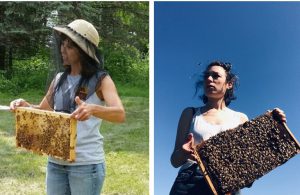
Becky Masterman led the UMN Bee Squad from 2013-2019. Bridget Mendel joined the Bee Squad in 2013 and has led the program since 2020. Photos of Becky (left) and Bridget (right) looking for their respective hives. If you would like to contact the authors with your number stories or thoughts, please send an email to mindingyourbeesandcues@gmail.com.
Knowing the status of food for your bees is important. Beekeepers usually work backwards, as they place their bees and measure the honey. If honey production is low (compare yours to the average honey yield), then it is possible that there are not adequate resources for your bees. If honey production is high, then you are in luck. If you planted flowers specifically for your bees to make honey on, then it isn’t luck, but good planning.
Should we be measuring some of the pollinator habitat in our states? We think it is a great idea and good to know if the numbers are going up or down. Some numbers, like acres planted in CP42 Pollinator Mix in the Conservation Reserve Program are being measured. Is it possible for state or federal agencies to keep track of the habitat they have installed without too much of a record-keeping burden? We don’t know but think we should ask.
Acknowledgments and suggestions:
The authors would like to thank Dr. Marla Spivak for helpful edits and suggestions.







